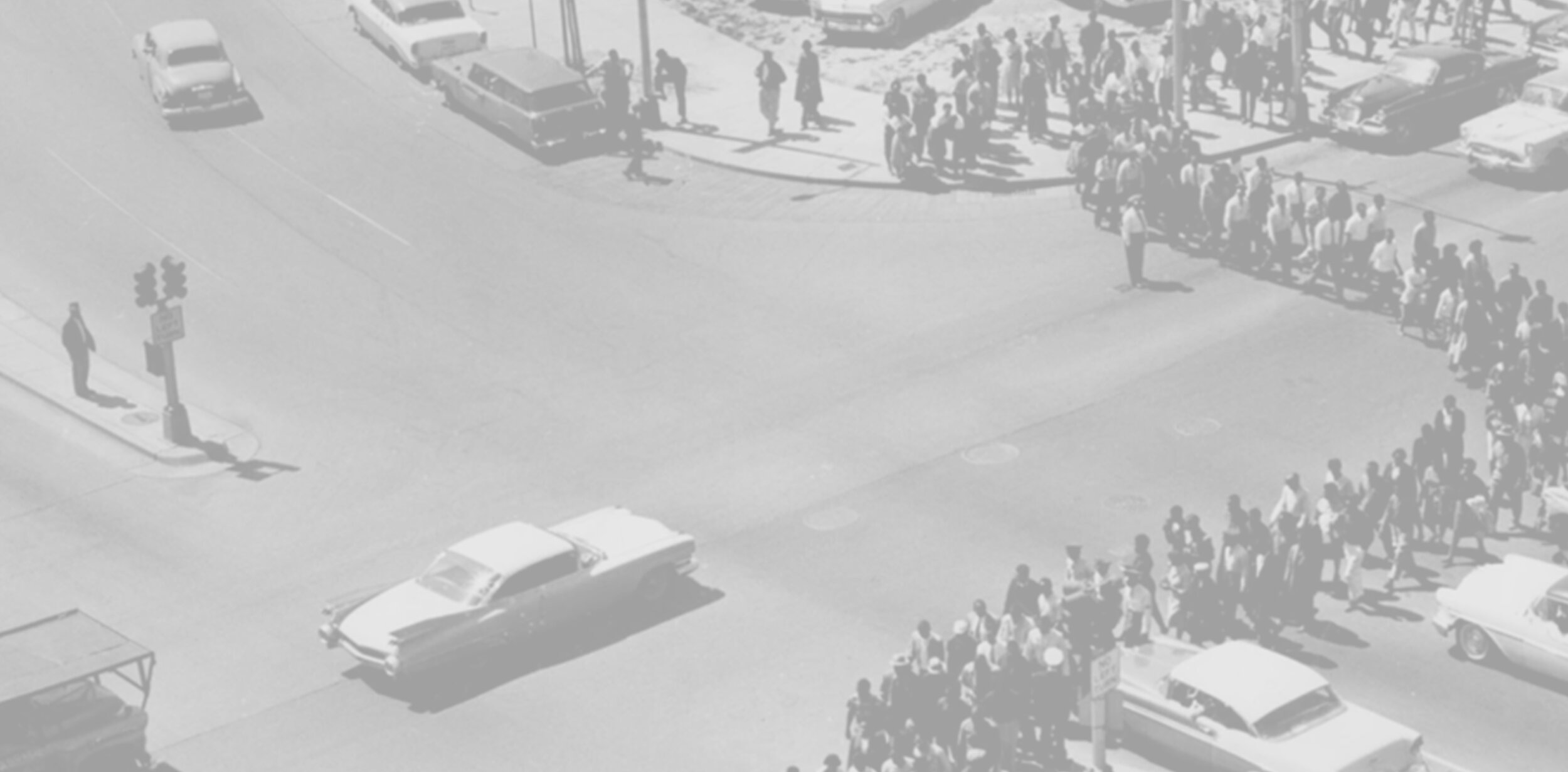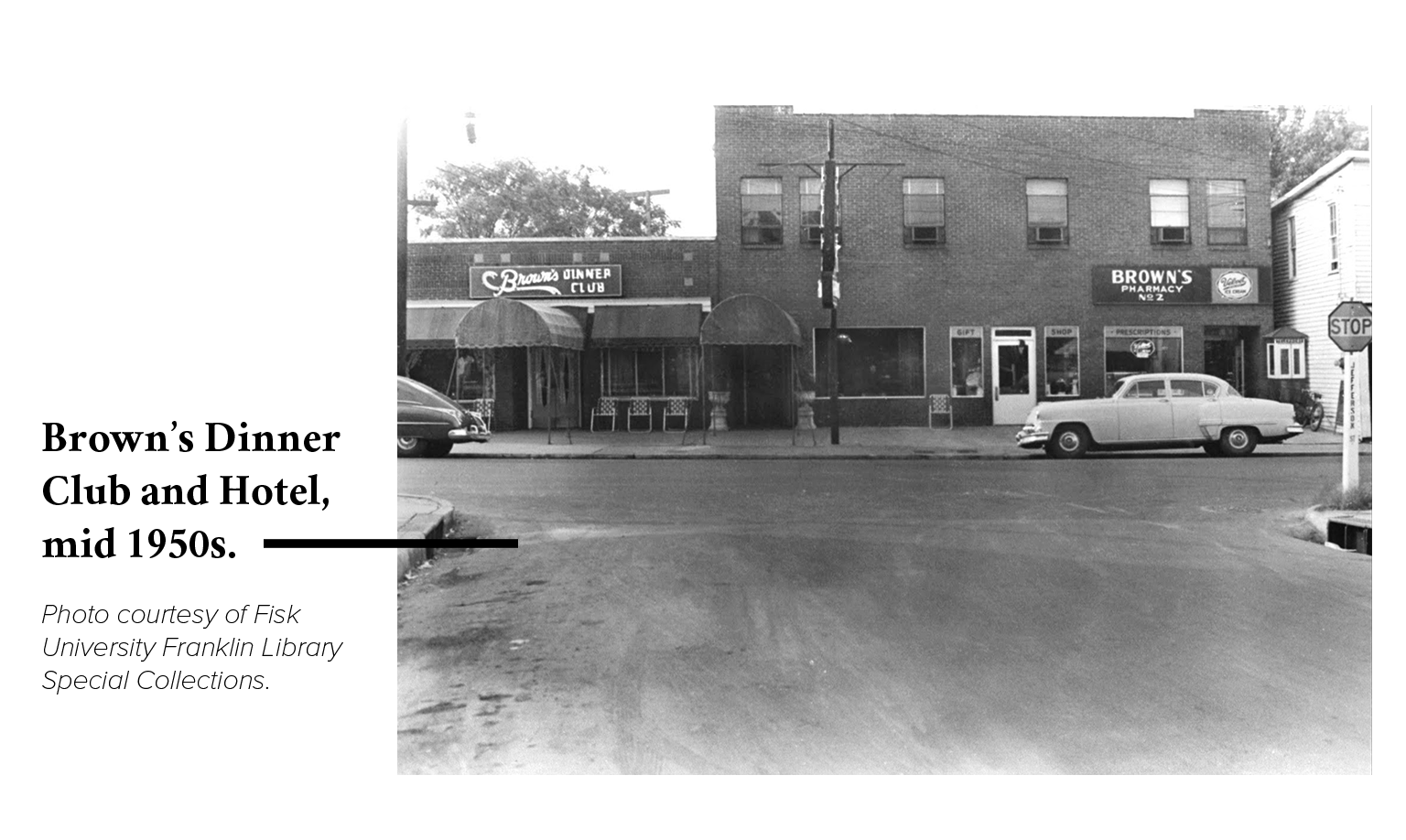
Speakers:
Jefferson Street Residents: Lorenzo Washington (owner of Jefferson Street Sound Museum) and the late Jesse Boyce (historic musician)
BLUES Researchers: Rogers Hall, Dave Owens, Ben R. Shapiro
Context:
A video and audio recorded transect walk down Jefferson Street in Nashville, Tennessee in September of 2015 wherein researchers and Jefferson Street locals discussed stories, histories, and issues brought up by noticing places along the walk; adapted to narrative reporting form and annotated with historically related media
BACK THEN
ROGERS HALL:
So if you look – as you looked up the street you would see stuff happening all the way up the street?
LORENZO WASHINGTON:
Yeah, all the way up, yes.
JESSE BOYCE:
I’ll give you an example—give you a very good example with the restoration that has taken place east Nashville, south Nashville.
When you walk by you see people sitting out and—on porches and eating dinner.
There’s a band in the background even in the afternoon.
6:00 in the evening a jazz band might be playing.
And the door might be ajar and you could hear people.
It was—it was like normal. It wasn’t like it was rowdy. It was like south Nashville.
You drive up and down Jefferson Street and you can see people sitting around eating, dining.
Music is going on, bars are open.
That’s what it was like.
Now like I was saying—now the last time I think we were together when we took that tour that night around Nashville, we saw that every place in Nashville has reopened again except for Jefferson Street.
HALL:
Yeah.
BOYCE:
And we know that there’s a plan.
Our goal is to just be a part of it.
To be a part of the decision-making process
To make sure that we have the kinds of clubs, the kind of restaurants, and places like that that would reflect what we had because what we had is what we have now in other areas.
SPEAKER BATTLE
WASHINGTON:
In those days – from ’69 to ’72, you know,
I was in and see when they were living in apartments and all in the city, they moved into an apartment next door to mine, that’s how I got to meet these guys [musicians], they moved right next door.
I mean in this apartment man with the music
Man, they came in there with speakers like that, it was like Johnny Jones and Jimi Hendrix
They came in there with speakers like that and moved next door to me, I’m over here got a little bitty speakers sitting on top of the stereo you know?
HALL:
Haha yeah
WASHINGTON:
Well, these guys — man, they busted my walls down, man!
You know, they’re in an apartment and they busted my wall down.
So that’s when I said the heck with this, I went and got me some speakers like that and put it right up against the wall.
So they would kind of knock down the room a little bit, man, and then after that we got to be friends.
We were hanging with each other, you know next to the room, real neighbors after that you know and that’s how I got to be a part of all of these scenes, you know what I mean?
CLUB DEL MOROCCO
WASHINGTON:
See and the Del Morocco [Club] was sitting right there close to where he’s coming off at, it may have been up this way a hair...
HALL:
Any of the surrounding buildings there at the time or are those new?
WASHINGTON:
No, those?
That’s new because back up in that field over in there was a beauty shop –hair salon school.
And that–as a matter of fact– the gentleman that owned the Del Morocco owned that school and Jimi Hendrix stayed upstairs in that building: it was right over there.
I got a picture of that school somewhere...
CLUB BARON
WASHINGTON:
Oh, now this is the great Club Baron.
This is where Jimi Hendrix and Johnny Jones had that great duel and that duel has been known all over the country that it happened here at the Club Baron.
So – but we had a lot of great folk to play here in this club, you know Little Richard, this was the home for Little Richard, this is where, this is where he called home here at the Club Baron.
BOYCE:
Club Baron. Oh yeah.
WASHINGTON:
Yeah and not just him, even Marvin Gaye is one of my greatest artist you know, and Marvin Gaye played here in this club you know?
Ike and Tina Turner played here in this club.
BOYCE:
Before the fame and all of that. This was their circuit.
WASHINGTON:
Yeah, this was before all of that, so this was a great spot to come. Now the younger folk, hardly got an idea
UPSTAIRS
HALL:
Did you play upstairs with Little Richard?
BOYCE:
I played in this club when Jimi Hendrix used to come and we used to like have jam sessions when you could kind of like just walk in with your instrument and when it was your turn, you know once they – if they ever turned it over, you can go and plug in and you could play.
So yeah I did get to jam with Jimi Hendrix here.
BEN R. SHAPIRO:
What was that like?
BOYCE:
It was amazing. I was just trying to hang for dear life but trying to show what I had and see if I would be – you know, what I was doing was cool or accepted, you know musicians are like that and they like what I was doing, obviously because they let me stay on stage.
WASHINGTON:
But during those days, but during those days that Jesse is speaking of, Jimi Hendrix was just another player.
Jimi Hendrix didn’t have any fame at that time. Jimi Hendrix – the folk here in this town, the real musicians, they didn’t care much for Jimi Hendrix.
HALL:
He played really wild stuff like behind his back…
WASHINGTON:
Yeah and he wouldn’t stay in the group, these guys was pocket players you know, they’re group players you know and Jimi Hendrix was none of that.
And that’s how – that’s why he got fired and out of some places and he actually got fired in some of these places.
They didn’t let him back in and not because he was a bad person, he just wasn’t – well he wasn’t a group player you know? A team player.
BOYCE:
He’s not a band member, he’s a band leader.
WASHINGTON:
He’s a band leader.
BOYCE:
And that’s how he played.
WASHINGTON:
And you know you could talk to a number of the musicians and I have you know, I’ve talked to none of – a number of them and they all say the same thing.
This is where I get my story from as far as the kind of person he was on stage you know?
BOYCE:
Billy Cox played here also during that time, Billy Cox of course being his bass player – Jimi’s bass player when he did become or start to become famous. His roots are here as well.
THE INTERSTATE
DAVE OWENS:
We’ll just ask the neighborhood, going down and the freeway was the final blow
…or is the freeway the start or the end of the neighborhood?
WASHINGTON:
Oh the freeway was the final blow.
Well, yeah it was the final blow because the community was kind of going down because the community was being swept by the police you know what I mean?
They’re saying they’d go clean it up, you know back then, almost all black folk is you know to try to make ends meet know selling whisky you know, you’re gambling…
OWENS:
And all of the Civil Rights stuff too weren’t they?
WASHINGTON:
Yeah and see that’s when the interstate really came through man, because see this interstate was supposed to go around by the river.
It was supposed to go around by the river and being that we were having all these marches and stuff, they say, “Okay, we’ll fix them. We’ll fix them.”
That’s when the interstate right straight to the city, straight to Jefferson Street and then that – for like two or three years, this place was all tore up because first they had to tear out before they could put up.
OWENS:
This is all houses and stuff right…
WASHINGTON:
Yeah there was housing, yeah.
So they had brick and concrete and asphalt and shit just piled up back here.
You could not even come up the street. You had to go all the way around and come back down to Tennessee State you see?
So – and they did that here, they did it on 12th Avenue, and 18th up here.
They got a bridge, and everywhere they got a bridge they had to tear up that part of the city okay?
So they totally separated the schools.
OWENS:
Yeah that’s right, yeah.
WASHINGTON:
You see? Tennessee State [University] from Fisk [University], told you to go all the way around.
MOVERS AND SHAKERS
BOYCE:
Well, this is—this is actually beneath a bridge that’s being redesigned as a kind of monument to some of the movers and shakers, innovators, people who lived, and worked, who created on Jefferson Street.
And that’s [Gateway to Heritage Plaza]—that’s pretty awesome right there.
Yeah. A lot of those people I’m not familiar with that were here years before I moved to Nashville which was in 1972.
Although I’ve been commuting back and forth, and playing, and hanging out on Jefferson Street.
They have obviously included a lot of people who are just well-known.
And then some who are not, but were some of the original contributors to the life of Jefferson Street whether it was in education or as entrepreneurs, or in the marches.
It’s pretty cool.
And they’ve done a lot of work on this thing, man.
Turning it into an area where people can actually come and hang out, and have special events. I think the only thing they’re going to need is some fans, right?
SHAPIRO:
They have event—events under here?
BOYCE:
Yeah. Yeah, I’m sure that once they finish it, it’ll be a place where people, you know.
We can do--and—and the first place I saw this was like in Kentucky in Louisville where they have an underpass or bridge where under the bridge the people are able to set up--
OWENS:
Oh wow.
BOYCE:
With vendors and—and food, and fans.
OWENS:
It’s a great location.
BOYCE:
It is.
It’s perfect, you know.
Just close the street off, you know.
Makes it perfect for walking around.
All rights to images and songs belong to their respective owners and are used for educational purposes as a part of scholarship and research through the BLUES project.
For details on the process and goals of this project, view my presentation here.


